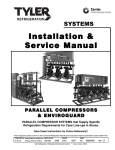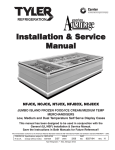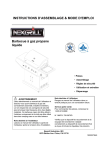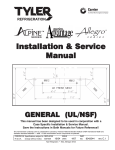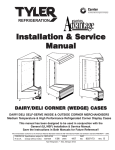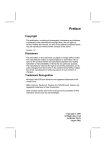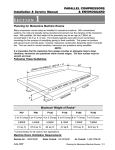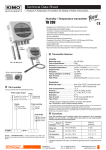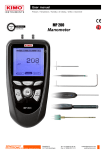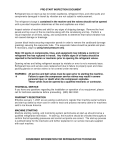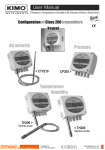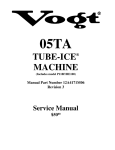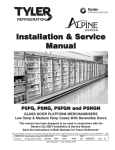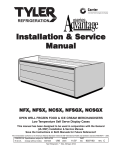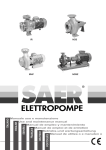Download Installation & Service Manual PARALLEL
Transcript
Installation & Service Manual SECTION PARALLEL COMPRESSORS & ENVIROGUARD 12 Defrost Control Strategies Temperature termination for all hot gas and electric defrost equipment is recommended with a termination sensing device at each fixture or coil. Frost build-up on coils varies depending on loading, traffic and ambient temperatures, consequently the required defrost time will also vary. If defrost termination is not sensed at each coil, there is a risk of other coils in the line-up not completely defrosting. This could cause icing, over-defrosting, and/or product quality problems. Electric Defrost On all TYLER cases (except the N6F(L) multi-shelf freezers) electric defrost termination can be done with the current sensing relay in our defrost panel. Therefore, no control wires are required between these cases and the compressor systems, helping reduce installation costs. Each case is independently terminated from the electric heat source by an inline klixon thermostat which opens-on-rise. When the last heater shuts off, the lack of current deactivates the current relay and initiates refrigeration. This time-tested method assures each case gets defrosted but prevents overdefrosting by getting the refrigeration back on quickly. The N6F(L) multi-shelf freezer cases have defrost contactors located at the case and these have an auxiliary contact that closes when the termination thermostat de-energizes the contactor. These contacts are wired in series if more than one case and when all are closed, the clock solenoid is reset, again allowing each case to independently terminate based on its own needs. When using an electronic controller with electric defrost, the controller will still initiate the defrost based on time. The sensors should still be placed in each case at the same location as our standard defrost termination thermostat. Multiple sensors on the same defrost circuit should be used so that all cases are satisfied before terminating heat and restarting refrigeration. The compromise is some danger of over-defrosting if some cases have less frost loads than other on the same circuit. The standard klixons must be kept in the circuit for U.L. requirements, but changed to 70°F termination to act as a safety and prevent cross controlling. In lieu of sensors, the standard defrost klixons may be monitored by the computer controller to terminate defrost. Gas Defrost When using a standard clock system with gas defrost, the clock will initiate the defrost based on time, and it will restart the refrigeration based on a fail safe time plus 5 minutes drain down time. Defrost termination by thermostats at the display fixture will only close the gas supply solenoid at the compressor rack. Termination thermostats at the display case (or evaporators in a walk-in cooler) should be connected in parallel and wired for open-on-rise. Once all thermostats are satisfied simultaneously, flow to the fixtures will cease. Once the fail safe/drain time has expired, the valves at the compressor rack will return to the refrigeration mode and pull down begins. All termination sensors should be mounted on the bypass check valves around the expansion valve. Fans are cycled off during the defrost except on horizontal type freezers (dual temps will cycle in medium temp mode). An alternative using electronic controllers to control the gas valve from sensors that replace the original defrost limiting thermostats. The sensors are located at the same sensing points as the thermostats. For best results, these should be connected to cycle only the gas valve. June, 2007 Defrost Control Strategies / 12-1 PARALLEL COMPRESSORS & ENVIROGUARD Refer to the electronic controller installation manual when using thermostats for termination instead of electronic sensors. Some controllers require a close-on-rise indication. If close-on-rise is used, wire the thermostats in series. Other controllers allow open-on-rise or close-on-rise indication. If open-on-rise is used, wire the thermostats in parallel. Fan Control & Defrost Termination Temperatures The following charts list specific fan control and defrost termination temperatures for electric, time off and gas defrost. Additional information or models not shown in the following charts should be obtained from the O.E.M. These guidelines were established to help assure that electronic defrost controllers will not sacrifice proper equipment operation or cause costly problems. The best sensing points for termination vary with manufacturer and style of case. These locations should be adhered to per the manufacturer’s recommendations. Electric & Time Off Defrost Requirements Chart CASE DATA ELECTRIC DEFROST TIME OFF DISCH. EPR FAILSAFE TERM. FAN FAILSAFE AIR TEMP SETTINGS DEF./ TIME TEMP CYCLE DEF./ TIME (°F) R-22 R404A DAY (MIN.) (°F) TEMPS. DAY (MIN.) -25 3 8 1 36 50 -------25 3 8 1 36 50 ------- MODEL NCSX, NCSGX NCNX, NCNGX, NCBX, NCEX NCJCX, NCJECX, NCJGCX, NCJGECX NTJCX, NTJGCX -25 3 8 1 36 50 --- --- --- -25/-15 3/7 8/14 1 36/60 50 --- --- --- 3 7 7 8 14 14 1 1 1 46 60 60 50 50 50 ------- ------- ------- 7 14 1 60 50 --- --- --- 7 14 1 60 50 --- --- --- 7/37 14/50 1 36 50 --- --- --- -15 7 14 1 46 50 --- --- --- -10 10 17 2-3 40 55 --- --- --- -8 -8 -5 19 12 13 27 19 21 1 1 1 46 46 46 60 60 50 40/20 40/20 --- ------- ------- +1 +1 18 17 26 25.5 1 1 46 46 60 60 40/20 40/20 ----- ----- (DUAL TEMP) NCWX -25 NMF, NMFG -15 NFX, NFSX, NFSGX -15 NFNX, NFNGX, NFBX, NFBGX, -15 NFEX, NFGEX NFJCX, NFJCGX, -15 NFJECX, NFJGECX NFMJCX, NFMJGCX -15/+22 (DUAL TEMP) NFWX, NFWGX, NFWEX N6F, N6FL P5FG, P5FGN (ANTHONY 101) (ELIMINAATOR) NFL P5FG, P5FGN (ANTHONY 101) (ELIMINAATOR) 12-2 / Defrost Control Strategies June, 2007 PARALLEL COMPRESSORS & ENVIROGUARD Installation & Service Manual ELECTRIC DEFROST TIME OFF CASE DATA EPR FAILSAFE TERM. FAN FAILSAFE DISCH. SETTINGS DEF./ TIME TEMP CYCLE DEF./ TIME AIR TEMP MODEL (°F) R-22 R404A DAY (MIN.) (°F) TEMPS. DAY (MIN.) NFX, NFSX, NFSGX +22 38 50 1 36 50 ------NFNX, NFNGX, NFBX, NFBGX, +22 38 50 1 36 50 ------NFEX, NFGEX NFJCX, NFJGCX, +22 38 50 1 36 50 ------NFJECX, NFJGECX NFWX, NFWGX, +22 38 50 1 36 50 ------NFWEX N3MGE +23 38 50 6 36 50 --6 28 +23 38 50 --------4 40 LPFMT (SELF-SERVE) LPFDT (SELF-SERVE) +23 38 50 ------4 40 NNG (DELI) +25 38 50 --------6 28 +24 38 50 --------4 40 LPFDT (DOME) +24 38 50 2 40 55 ------N6F, N6FL (MEAT) N2PSE (BULK) +24 43 56 --------6 28 (MEAT/DELI) +24 38 49 6 36 50 --6 28 TNG (DELI) +25 38 50 --------6 28 N3MG, N3HM, N3HMG +27 38 50 6 36 50 --6 22 N3HME, N3HMGE +27 38 50 --------6 26 NSSD +27 38 50 6 36 50 --6 28 NMHP, NMGHP +27.5 49 62 --------4 44 NM, NMG +28 38 50 4 19 50 --4 34 +28 35 46 --------4 30 RCCG (RISER OPT. 2) RCCG (STD. RISER) +28 38 50 --------4 30 (RISER OPT. 1) LPD TNG (CHEESE) NHMGHP N2MHP N3HMHP, N3HMGHP N4MHP, N4MGHP N5M, N5MG N6MHP N2PS (BULK) (MEAT DELI) +28 +28 +28 +28 +28 +28 +28 +28 +28 +28 +28 NDRLHPA (SHELVING) +28 NNG (CHEESE) LDSSI +28.5 N5MHP, N5MGHP +29 N3MGHP, N3MGHPE, +29 N3MGHPEX LPFMT (DOME) +29 June, 2007 38 43 49 48 49 49 38 48 43 38 37 50 56 62 61 62 62 50 61 56 49 49 ------------6 ----6 --- ------------36 ----36 --- ------------50 ----50 --- ----------------------- 4 6 4 6 6 6 6 6 6 6 4 30 28 44 26 28 28 32 26 28 28 45 43 44 49 49 56 57 62 62 --------- --------- --------- --------- 6 4 6 4 28 40 26 32 38 50 --- --- --- --- 4 40 Defrost Control Strategies / 12-3 PARALLEL COMPRESSORS & ENVIROGUARD CASE DATA ELECTRIC DEFROST TIME OFF DISCH. EPR FAILSAFE TERM. FAN FAILSAFE AIR TEMP SETTINGS DEF./ TIME TEMP CYCLE DEF./ TIME MODEL (°F) R-22 R404A DAY (MIN.) (°F) TEMPS. DAY (MIN.) TLD, TLD(2/4/6)(L/R) +30 52 67 --------4 20 N2P (MEAT/DELI) +30 38 49 6 36 50 --6 28 NLD, NFD, NVD +30 36 47 --------1 46 N6DHP(LR/MR) +31 52 66 --------6 16 NHDHP(L/M) (SHELVING) +31 52 66 --------6 24 (PEG BARS/MIXED) +31 50 64 --------6 26 (PRODUCE INSERT) +31 53 36 --------6 24 N6D(LR/MR) +32 44 57 4 24 41 --4 24 NHD(L/M) +32 44 57 4 24 41 --4 24 LD(48/54/60/72) +32-35 41 53 --------6 20 +33 43 56 --------6 28 N2P (BULK) N6D(L/M/H) +33 44 57 4 24 41 --4 24 +34 43 56 --------3-4 40 NP (BULK) P5NG, P5NGN +34 51 65 --------1 34 N6DN(L/M/H) +34 44 57 6 18 41 --6 18 N6DHP(L/M/H)A +34 52 66 --------4 18 (ALL APPLICATIONS) N6DHPAC(L/M/H)A N5P (BULK) NPW, NPWE, NPWEE, NPE (BULK) N5D, N5DH, N5DL N5DSC N2PSSC NRPIE, NRPIEE NLBR FDESC N1P (BULK) N3PL, N3PH (BULK) N4P (BULK) N4PHP (BULK) N1PHP (BULK) NLM, NFM, MVM, NLF, NFF, NVF TLM, TLF, TLM(2/4/6)(L/R) +34.5 +35 +35 52 43 43 66 56 56 ------- ------- ------- ------- 4 3 1 20 40 60 +35 +35 +35 +35 +36 +37 +38 +38 +38 +39 +42 --- 37 ----43 51 --43 43 43 60 60 36 49 ----56 65 --56 56 56 75 75 47 ------------------------- ------------------------- ------------------------- ------------------------- 4 6 4 1 6 6 3-4 3 3-4 2 2 1 24 28 18 60 20 25 40 40 40 10 10 110 --- 37 49 --- --- --- --- 2 70 Termination thermostats are open-on-rise. See case specific Installation & Service Manuals for proper locations. 12-4 / Defrost Control Strategies June, 2007 Installation & Service Manual PARALLEL COMPRESSORS & ENVIROGUARD Hot Gas Defrost Requirements Chart MODEL NCSX, NCSGX NCNX, NCNGX, NCBX, NCEX NCJCX, NCJECX, NCJGCX, NCJGECX NTJCX, NTJGCX CASE DATA DISCHARGE AIR TEMP (°F) -25 -25 DEFROSTS PER DAY 1 1 HOT GAS DEFROST FAILSAFE TERM. TIME TEMP (MIN.) (°F) 25-30 55 25-30 55 FAN CYCLE TEMPS. ------- -25 3 8 1 25-30 55 ---- -25/-15 -25 -15 -15 3 7 3 7 7 8 14 8 14 14 1 2-3 1 2 2-3 25-30 20-25 25-30 16-20 25-30 55 55 55 55 55 ---------------- -15 7 14 2-3 25-30 55 ---- -15 7 14 2-3 20-25 55 ---- -15/+22 14 50 14 2-3 2-3 2-3 20-25 16-20 20-25 55 55 55 ---50/40 ---- (DUAL TEMP) NCWX NMF, NMFG NFX, NFSX, NFSGX NFNX, NFNGX, NFBX, NFBGX, NFEX, NEGEX NFJCX, NFJGCX, NFJECX, NFGECX NFMJCX, NFMJGCX EPR SETTINGS R-22 R404A 3 8 3 8 NFWX, NFWGX, NFWEX N6F, N6FL P5FG, P5FGN -15 7 37 7 -10 10 17 3-4 22-25 60 60/40* (ANTHONY 101/) -8 -8 -5 19 12 13 27 19 21 1 1 2 20-25 20-25 17-20 55 55 55 25/10 25/10 ---- +1 +1 +22 18 17 38 26 25.5 50 1 1 2-3 18-20 18-20 16-20 55 55 55 25/10 25/10 50/40 +22 38 50 2-3 16-20 55 50/40 +22 38 50 2-3 16-20 55 50/40 +22 38 50 2-3 16-20 55 50/40 +23 +24 +24 +27 +27 +28 +28 38 38 38 38 38 38 38 50 50 49 50 50 50 50 6 3-4 6 6 6 4 6 12-15 22-25 12-15 12-15 12-15 12-15 12-15 55 60 55 55 55 55 55 ---60/40* ---50/40 50/40 50/40 50/40 (DUAL TEMP) (ELIMINAATOR) NFL P5FG, P5FGN (101/E2 with HEAT) (ELIMINAATOR) NFX, NFSX, NFSGX, NFNX, NFNGX NFBX, NFBGX, NFEX, NFGEX NFJCX, NFJGCX NFJECX, NFJGECX NFWX, NFWGX, NFWEX N3MGE N6F, N6FL (MEAT) N2PSE (MEAT/DELI) N3MG, N3HM, N3HMG NSSD NM, NMG N5MG * Primary Fans Only June, 2007 Defrost Control Strategies / 12-5 PARALLEL COMPRESSORS & ENVIROGUARD MODEL N2PS (MEAT/DELI) N2P (MEAT/DELI) N6D(LR/MR) NHD(L/M) N6D(L/M/H) N6DN(L/M/H) CASE DATA DISCHARGE AIR TEMP (°F) +28 +30 +32 +32 +33 +34 EPR SETTINGS R-22 R404A 38 49 38 49 44 57 44 57 44 57 44 57 DEFROSTS PER DAY 6 6 4 4 4 6 HOT GAS DEFROST FAILSAFE TERM. TIME TEMP (MIN.) (°F) 12-15 55 12-15 55 15 55 15 55 15 55 15 55 FAN CYCLE TEMPS. ------50/40 50/40 50/40 50/40 • Ice cream discharge air temperatures are -28, -25 & -8°F. Frozen food discharge air temperatures are -20, -15, -10, -5 & +1°F. All other discharge air temperatures are for medium temp applications. • Most low temperature cases can be set up for dual temp application (frozen food / medium temp). Only the NTJCX & NTJGCX cases can be set up for split temp application (ice cream / frozen food). • Termination thermostat bulbs are mounted on the bypass check valves around the expansion valves. • Multiple cases, on a circuit using open-on-rise termination, should be connected in parallel so that all are satisfied before stopping the gas flow. • An additional 5 minutes of drain down time should be allowed for after the failsafe time, or added to the failsafe time if not a separate function before the refrigeration comes on for electronic controllers only. 12-6 / Defrost Control Strategies June, 2007 Installation & Service Manual SECTION PARALLEL COMPRESSORS & ENVIROGUARD 13 Gas Defrosting Gas defrost is accomplished by diverting hot gas from the compressor discharge, down the suction line, and into an evaporator where it condenses to liquid refrigerant. This provides a very rapid means of defrost. Gas defrost is available for cases operated by a parallel system. Gas defrost uses superheated compressor discharge gases to provide the heat source to melt the ice off of the evaporator coils. About 25% of the cases can be defrosted at a time, the other 75% of the cases are needed as a heat source for the defrosting cases. Gas defrosts are initiated by a multi-circuit time clock or a computer controller. Both controls set the defrost initiation and duration times for all of the separate refrigeration circuits. It is necessary to program defrosts in the proper sequence. Care must be taken not to schedule more than one defrost at a time. No more than 25% of the rack system can be set to defrost at one time. Gas Defrost Operating Principles In a gas defrost system, hot refrigerant vapor is pumped directly through the evaporator tubing. The system uses a series of valves to supply superheated vapor from the compressor or saturated vapor from the receiver, through the suction line, to the evaporator(s) to be defrosted. This series of valves is explained in more detail on page 15-3. At a pre-determined set time the time clock or computer controller will close a circuit’s suction line valve to the compressor and open the hot gas supply valve to the circuit being defrosted. The hot vapor rushes to the evaporator, warming the coil. The hot vapor is condensed into liquid in the evaporator and then the liquid is returned to the liquid manifold via a bypass around the expansion valve. This liquid is, in turn, used as the refrigerant supply to other cases . To make certain that the liquid flows from the evaporator of the defrosting fixture(s), a pressure differential is established between the compressor discharge pressure and the liquid header. When defrost is initiated, a DDPR valve throttles the normal hot vapor flow to the condenser. An OLDR valve adjusted for a minimum of 20 pounds of differential (located at the outlet to the receiver) is also placed on the line to drop the pressure in the liquid manifold and ensure flow from the defrosting evaporator to the liquid manifold. For proper adjustment, see table on page 10-2. June, 2007 Gas Defrosting / 13-1 PARALLEL COMPRESSORS & ENVIROGUARD Gas Defrosting Programming Gas defrosts are programmed to allow for a defrost period and a dripdown period or “clear time”. This type of defrost operation allows the problem areas in the case to completely clear without subjecting the refrigerated product to excessive warm up. Temperature termination thermostats are used to sense when the refrigerant in the evaporator coil reaches a specific temperature. DEFROST INITIATION GAS FLOW STOPS DEFROST TIME REFRIGERATION CYCLE RESUMES CLEAR TIME When the termination temperature is reached (70°-75°F), the hot gas solenoid will close. If the coil cools and the termination time has not elapsed, then the hot gas flow will resume. This will continue until the allotted failsafe time on the time clock or computer controller has been reached. The multi-circuit time clock or computer controller will initiate defrost by introducing hot gas flow to the fixtures. Defrost will continue until the temperature termination thermostats on all cases in the defrosting lineup close. When all the termination thermostats are satisfied, the hot gas solenoid will close. Refrigeration will not restart until the entire time period set on the defrost clock passes. This allows adequate clear time without overheating. 13-2 / Gas Defrosting June, 2007 Installation & Service Manual SECTION PARALLEL COMPRESSORS & ENVIROGUARD 14 Multi-Circuit Time Clock Module The multi-circuit time clock is a modular time clock with a frame, drive motor and individual program modules. The program modules clip into the frame and are held in place by a spring loaded latching lever. Operation When the time clock is to be set up for initial operation, the following must be done: 1. The number of defrosts for a specific circuit is set by inserting the black trippers into the 24-hour time dial (1 for each defrost). 2. Each of the 2-hour minute dials must be set for the length of the defrost period (failsafe). As the 2-hour dial rotates, so do the 24-hour dials. The 2-hour dial makes a complete rotation every 2 hours. Defrosts will start when a tripper is reached on the 24-hour dial and will continue for the time period set on the 2-hour time dial. Setting the Multi-Circuit Time Clock Setting the defrost times on the clock is a simple procedure. Follow these precautions: PRECAUTIONS • Do not set the program timer with the circuit energized. De-energize the control circuit to prevent personnel injury or inadvertently tripping too many defrosts at one time. • Do not use excessive force when turning the minute dial levers. Rotate the dial in a counter-clockwise direction. Setting 1. Insert black plastic trippers into the 24hour time clock at the times of day the defrosts (indicated by the black numbers on the white dial) are to occur. 2. Set the failsafe time on the 2-hour clock by rotating the copper termination lever so the pointer indicates the desired time period. 3. Set clock to the correct time of day (indicated by the white numbers on the smaller black wheel to the left of each 24-hour module) using the black drive gear on the motor module. June, 2007 Multi-Circuit Time Clock Module / 14-1 PARALLEL COMPRESSORS & ENVIROGUARD Multi-Circuit Time Clock Module Replacement If a module needs to be replaced, be sure to use the right part. There are 4 different modules. The modules are designated with the letters A, B, D and E. Replace an A with an A; a B with a B; and so on. These modules have been factory set. Do not try to change them! “A” Modules - Red Tab set at 75 minutes. “B” Modules - Red Tab set at 45 minutes. “D” Modules - Red Tab set at 15 minutes. “E” Modules - Red Tab set at 105 minutes. Removal and/or Installation and Alignment of Individual Program Modules 1. To remove a program module, rotate the black reduction gear on the motor module until the red tabs on all the 2-hour program dials come to the 12 o’clock position. Then pull out and up on the bottom of the module latching lever, disengage and point module up from frame to remove. 2. To re-install a program module, follow step 1 above, and rotate the trailing modules by hand until all red tabs are at 12 o’clock position. Check to be sure that the black numbers on all the 24-hour dial are in the same position as those on the modules already in the frame. Then fit the module cut out (located above the switches) into the slotted frame rod, align the tongue/groove on either side of the module, and snap the module down over the non-slotted frame rod. Check to be sure all red tabs line up and all 24-hour dial numbers line up. Removal and/or Installation of the Drive Module 1. To remove the drive module, rotate black reduction gear until tongue/groove with program module number 1 is parallel to the mounting surface. 2. Loosen hex nut fully. 3. Slide complete motor module parallel to the mounting surface and toward the 24-hour dials until the three locator studs clear their key slots, then remove the module. 4. To reinstall, reverse the above steps. 14-2 / Multi-Circuit Time Clock Module June, 2007 Installation & Service Manual PARALLEL COMPRESSORS & ENVIROGUARD Program Charts for Multi-Circuit Timers Below are program charts for the multi-circuit time clock. These charts may be used to design a defrost program for an entire parallel system. June, 2007 Multi-Circuit Time Clock Module / 14-3 Installation & Service Manual SECTION PARALLEL COMPRESSORS & ENVIROGUARD 15 Refrigeration Circuits - Electric, Time Off or Gas Defrost Time Off or Electric Defrost Circuits The following component arrangements are associated with cases or unit cooler coils equipped with electric defrost heaters, air or timed off-cycle defrost. The purpose of these arrangements is to stop the flow of refrigerant through the evaporator while it is defrosting. Termination with electric defrost is by (TG) sensing relays (all cases except N6F & N6FL) or a termination pilot circuit. All termination methods use the failsafe feature of the multi-circuit time clock or a control relay in a computer controlled application. A. Liquid flow can be interrupted by a factory mounted, normally closed, liquid line solenoid valve (1) controlled by the multi-circuit time clock or computer controller. An evaporator pressure regulator (EPR) (2) valve is factory installed on the suction stub of the compressor rack for temperature regulation (by pressure) of the entire lineup. B. A variation of “A” omits the liquid line solenoid valve. Instead, the EPR (3) is equipped with a solenoid valve controlled by the multi-circuit clock or computer controller. When the solenoid valve is energized, it will force the EPR to shut (suction stop) and refrigerant flow in the lineup will cease. C. When precise case temperature control is desired, each case is equipped with a liquid line solenoid valve (4) (normally closed) which is cycled by a thermostat. The thermostat will use a bulb to sense entering air temperature. No EPR valve is required. The control circuit for these multiple solenoids will be controlled by the multi-circuit clock or computer controller. D. This lineup is a variation of “A”. The suction stop feature of an EPR (5) is employed for defrost in combination with a liquid line solenoid. This slows and eventually stops the feeding of refrigerant through the expansion valve while in defrost and is often used on medium temperature circuits. June, 2007 Refrigeration Circuits / 15-1 PARALLEL COMPRESSORS & ENVIROGUARD Gas Defrost Piping Arrangements E. (SORIT, BEPRS) - This type of EPR valve (8) is a minimum pressure drop valve which uses the system’s high pressure to operate the valve. With regards to Sporlan’s SORIT, the initial S stands for the solenoid stop, ORI stands for “Open-on-Rise of Inlet Pressure”, and the “T” is the schrader access valve used in adjusting the valve (8). The SORIT’s suction stop solenoid is controlled by the time clock or computer controller and closes the valve during defrost. F. An optional variation of “E” adds a liquid solenoid (9) just upstream of the expansion valve. The solenoid can be used for temperature control in conjunction with the EPR. On all of these arrangements, the hot gas line is equipped with a solenoid valve. At the beginning of defrost, the valve is opened, allowing hot gas to flow to the evaporator coil. A termination thermostat operating a pilot circuit shuts off the gas flow when termination temperature has been reached in the fixture. The EPR valve does not open again until a drip down or drain down time has been allowed. A 10 to 26 minute time period allows the evaporator coil and drain pan to clear. The entire time period set on the multi-circuit time clock or computer controller is called the “Failsafe” time period; it includes both the defrost and the drip down time. However, if at any time during this drip down period a fixture’s temperature drops 10°F or more, the defrost will be reinitiated. Although this is true for all cases, it is most prevalent in the N6F(L), NFJGCX, P5FG and P5FGN cases. It will continue until either temperature termination or Failsafe time from the initial defrost termination passes. 15-2 / Refrigeration Circuits June, 2007 Installation & Service Manual PARALLEL COMPRESSORS & ENVIROGUARD Refrigeration Circuits Piping Diagram Gas Defrost Circuits Hot gas from the receiver is used to defrost cases by reversing the flow through the evaporator coil. This flow reversal must be done by devices added to the parallel rack piping, including the hot gas manifold which is run parallel to the suction and liquid manifolds. System pressure must be directed to the portion of the system that is in defrost. This is accomplished using an electrically operated DDPR valve (6) in the discharge line. The system pressure pushes hot gas through the suction line, where it condenses into liquid in the frost laden evaporator coil. Movement of the condensed hot gas liquid into the liquid manifold is induced by creating a 20 pound drop in the liquid pressure. This is done with the normally open OLDR valve (7). When a part of the system goes into defrost, the OLDR valve (7) is energized and modulates to a partially closed position, creating the pressure drop required. This valve arrangement provides the necessary pressure difference to ensure a reverse flow through the specific branch circuit. The OLDR valve (7) and the DDPR valve (6) operate together during any defrost cycle. When the defrost is terminated the DDPR valve (6) and the OLDR valve (7) are returned to the open position allowing normal system operation to resume. This valve arrangement provides both system stability and the necessary difference in liquid pressures to ensure flow of the condensed hot gas liquid from the defrosting fixture. June, 2007 Refrigeration Circuits / 15-3 Installation & Service Manual SECTION PARALLEL COMPRESSORS & ENVIROGUARD 16 Receiver Gas Defrost Receiver gas defrost is accomplished by using the relatively cool gas from the top of the receiver. The cool gas is discharged down the suction line to the evaporator, where it begins to condense, giving up latent heat in melting the accumulated frost from the evaporator. The defrost gas, being at a relatively cool temperature at the start of defrost, reduces thermal stress on the piping, thereby reducing the possibility of line breakage and loss of refrigerant. The gas volume in the receiver is constantly being supplied from the compressor discharge line which maintains gas flow throughout the defrost cycle. Receiver gas defrost is available for case lineups operated by a parallel compressor system. Defrost is accomplished by using the cool saturated gas from the receiver at elevated pressures. The compressor discharge gas is injected into the receiver. As the discharge gas passes over the liquid in the receiver, it is desuperheated. This provides a positive pressure, which helps maintain the flow of liquid to the refrigerated fixtures during defrost. About 25% of the total load can be defrosted at one time, and the remaining 75% of the load is needed as a heat source for the defrosting cases. Receiver gas defrost is initiated by either a mechanical or electronic multi-circuit time clock or computer controller. These devices provide the proper sequence of defrosts. Only one circuit is to be defrosted at a time, if this is not adhered to, the entire system may operate improperly. Systems having a DDPR valve in the discharge line are to be set for a 20 psid differential across the valve. This valve is necessary in cold ambient areas, below 30°F, because it ensures adequate gas flow during defrost to the defrosting fixtures. Control Strategy (NC-1 Latent Heat / Receiver Gas Defrost) 1. Remote Condenser Fans are controlled by a pressure control, set for the minimum target pressure corresponding to 88°-89°F saturation temperature. This ensures adequate defrost during cold ambient temperatures. 2. Outlet Pressure Regulator (OPR) Valve is set for the target pressure corresponding to 86°-87°F saturation temperature. 3. Inlet Pressure Regulator (IPR) Valve is set for the target pressure corresponding to 94°-95°F saturation temperature. 4. The OLDR Liquid Solenoid Valve is energized during defrost to create a pressure differential. Refer to table on page 10-2 for proper adjustment. June, 2007 Receiver Gas Defrost / 16-1 PARALLEL COMPRESSORS & ENVIROGUARD Piping Diagram for Parallel System with Demand Cooling, Mechanical Subcooling & Latent Gas Defrost 16-2 / Receiver Gas Defrost June, 2007 Installation & Service Manual Piping Diagram June, 2007 PARALLEL COMPRESSORS & ENVIROGUARD for Parallel System with Latent Gas Defrost Receiver Gas Defrost / 16-3 Installation & Service Manual SECTION PARALLEL COMPRESSORS & ENVIROGUARD 17 Parallel System with NC-2 & Heat Recovery TYLER Refrigeration manufactures multi-compressor parallel systems with two or more compressors. They can be of various size and capacity and operate at different suction temperatures. All compressor units are electrically powered and use electro-mechanical switches or electronics to control their operation. The compressor control panel contains all the necessary controls to operate the compressors properly. The systems are designed to be used with remote condensers and optional heat recovery coils. The systems utilize either a horizontal or vertical receiver tank. Compressor horsepower sizes may be mixed for flexibility in capacity control. Each system is individually designed for the specific needs of a given application. It is unlikely that any two parallel system assemblies will be exactly alike. • A typical installation will usually consist of more than one parallel system. • A typical installation may use R-22 or R404A refrigerants. Separate loads will be connected to the parallel rack at the liquid and suction line manifolds. Temperature control at each individual circuit will be provided by an evaporator pressure regulator (EPR) valve in the suction lines or by thermostats with liquid or suction line solenoid valves. Typical Piping & Devices - All Systems See page 17-3 for “Piping Diagram for Parallel System with NC-2 & Heat Recovery”. All liquid refrigerant flowing out to the case and cooler circuits must pass through a replaceable core filter drier (1). This filter and the filters in the suction line of each compressor are important in keeping installation debris from damaging the components in the system. • The drier element absorbs and holds moisture, acids, sludge and varnish which may be in the system. A moisture indicating sight glass (2) tells when the drier needs to be changed; it also shows flow through the liquid line. A liquid level gauge on the receiver determines the system charge. Factory piping includes three ball shutoff valves (3) to aid in servicing. There are also service valves at each station on the liquid manifold (4) and suction manifold (5). • Additional ball valves (6) are recommended and optionally supplied for field installation at the points shown. This makes the completed system fully serviceable at any point with a minimum of refrigerant loss. Each compressor has a replaceable core suction line filter (7). A schrader valve is on the filter body; one can also be installed on the suction service valve of the compressor to make a pressure drop check of the filter’s condition possible. June, 2007 Parallel System w/NC-2 & Heat Recovery / 17-1 PARALLEL COMPRESSORS & ENVIROGUARD Discharge gas from the compressors is piped through an oil separator (8). Refrigeration oil is removed from the hot gas and oil mixture to be sent back to the oil float system. This lubricates the compressors and minimizes the amount of oil getting in the evaporators. Oil from the separator is piped into an oil reservoir and distributed to the oil level controls on each compressor. • Most parallels are equipped for heat recovery (HR) so that heat may be reclaimed and put back into the building. A diverting valve (9) redirects hot gas to the HR coil (10) when heat is demanded by the Environmental Control Panel thermostat. The Heat Recovery (HR) coil is optionally equipped with an inlet Pressure Regulator (IPR) on systems with Nature’s Cooling (NC-2 or NC-3). The IPR valve is standard on NC-2 systems. The valve raises the system pressure during heat recovery to get more heat out of the discharge gas. In most other systems, liquid from the remote condenser returns directly to the receiver. Natural subcooling is diminished since the liquid mixes in the receiver and warms, to some extent, in the machine room. NC-2 preserves the naturally cooled liquid’s temperature by bypassing the receiver when advantageous to do so. The bypass line is operated by a liquid temperature sensing thermostat (11). When liquid returning from the remote condenser rises to 70°F, the valve closes. The liquid then flows directly into the receiver. When outside temperature drops the condenser fans begin shutting off because they are set on a temperature sensing thermostat. When the temperatures fall, pressure in the system also drops. However, the pressure inside the receiver is allowed to fall only so far; the minimum allowable pressure is the point where system performance will be hurt. The receiver pressure is kept from falling below this minimum point by an Outlet Pressure Regulator (OPR) valve (12) located in a gas bypass line run from the compressor discharge to the receiver. As temperatures / pressures drop the OPR valve opens, allowing gas from the compressor discharge to maintain the pressure in the receiver. This also causes liquid to start backing up in the condenser because the receiver will be at a higher pressure than the condenser. During low ambient periods, the system pressure will be maintained at the setpoint of the OPR valve. • The OPR is also known as a downstream pressure regulator. NC-2 This system operates with the receiver continuously at the same head pressure as the condenser. Refer to “Pressure Regulator Settings” on pages 9-1 & 9-2 for proper pressure settings. Its design raises system efficiency by maximizing the amount of natural liquid subcooling while allowing the compressors to operate at the lowest possible compression ratios. Simplicity is attained by reducing the number of valves in the system. NC-2 functions with a normally open solenoid valve located in the liquid return line between the condenser and the receiver. With this valve open, there is direct and unconstrained liquid flow from the condenser to the receiver (head pressures are allowed to “float”). The only time the solenoid valve will close is during NC-2 operation or for gas defrost (if used). During NC-2 operation (when the temperature of the liquid returning from the condenser is less than 70°F) flow will completely bypass the receiver. NOTE Use of split condenser piping may reduce the effectiveness of NC-2. 17-2 / Parallel System w/NC-2 & Heat Recovery June, 2007 Installation & Service Manual Piping Diagram June, 2007 PARALLEL COMPRESSORS & ENVIROGUARD for Parallel System with NC-2 & Heat Recovery Parallel System w/NC-2 & Heat Recovery / 17-3 PARALLEL COMPRESSORS & ENVIROGUARD Parallel System with Heat Recovery & Companion In the medium temperature range, the typical refrigeration (case) load operates at 20°F suction temperature. Lowering the pressure to accommodate a few meat or deli operating at 10°-15°F would penalize the whole system. Because the lower the suction pressure at which a compressor is operated, the less efficient it is. The entire system would have to operate at this lower suction pressure. By adding a companion,one or more compressors operate at this lower efficiency rate, while the other compressor(s) run at peak efficiency. A companion compressor’s suction line runs directly to the meat or deli cases. A 2 pound check valve connection to the suction manifold allows the adjacent parallels to help pull down the meat/deli cases temperature immediately after defrost. If there were sufficient meat/deli cases to warrant it, the boosters could be on a separate parallel system. Ice cream case companion compressors on low temp systems work similarly. The normal low temp frozen food cases are at -20° to -25°F while the companion operates the ice cream cases at -35°F. The parallel compressors on the frozen food system assist the booster in rapid temperature pulldown after defrost through the 2 pound check valve connection. Companion Compressor Protection All companion compressors are equipped with a 2 minute delay to protect against short cycling. When a companion compressor is applied to a gas defrost system, an additional time-delay relay is used to lock the compressor out after a defrost for a few additional minutes. This allows the companion suction line to cool preventing possible liquid slugging and/or thermal cutout because of high suction line temperature. See page 17-5 for “Piping Diagram for Parallel System with Heat Recovery & Companion”. 17-4 / Parallel System w/NC-2 & Heat Recovery June, 2007 Installation & Service Manual Piping Diagram June, 2007 PARALLEL COMPRESSORS & ENVIROGUARD for Parallel System with Heat Recovery & Companion Parallel System w/NC-2 & Heat Recovery / 17-5 PARALLEL COMPRESSORS & ENVIROGUARD Parallel System with Mechanical Subcooling Mechanical subcooling makes the entire system more efficient and allows closer sizing of compressor to cases in the sunbelt states. It also provides a capacity reserve for hot weather protection. The subcooler compressor operates at a high efficiency suction temperature of approximately 40°F. Subcooler liquid supply is usually from a separate system. The liquid line feed to the expansion side of the subcooler is controlled by two paralleled, normally closed, solenoid valves upstream of two expansion valves (1). The solenoid valves are sized at 75% and 25% of the total subcooling load. The solenoid valves are thermostatically controlled (2). While the liquid inlet temperature is above 70°F, the 75% solenoid is energized. If the temperature falls below 70°F, the 25% solenoid is energized. The settings for the 25% thermostat are 55°F ON and 40°F OFF. The subcooler compressor is controlled and protected by its own pressure control. When liquid return temperature is above 55°F, the subcooler will cycle ON and OFF between 55°F and 40°F. See page 17-7 for “Piping Diagram for NC-1 & Mechanical Subcooling”. 17-6 / Parallel System w/NC-2 & Heat Recovery June, 2007 Installation & Service Manual Piping Diagram June, 2007 PARALLEL COMPRESSORS & ENVIROGUARD for Parallel System with NC-1 & Mechanical Subcooling Parallel System w/NC-2 & Heat Recovery / 17-7 PARALLEL COMPRESSORS & ENVIROGUARD Hot Water Piping Methods 17-8 / Parallel System w/NC-2 & Heat Recovery June, 2007 Installation & Service Manual SECTION PARALLEL COMPRESSORS & ENVIROGUARD 18 Component Description & Definitions Refrigeration Branch Circuit A Refrigeration Branch Circuit is a lineup or group of cases and/or coolers connected to a common liquid line solenoid and common suction line. The suction line may or may not be equipped with an EPR valve. Check Valve Parallel systems employ a number of spring loaded check valves of various sizes. They allow gases or liquid flow in only one direction. Three different spring loadings are used. Check Valve Locations “Normal” Check Valves - The spring above the valve disc assures positive return and seating. Applications: 1. In cases around the expansion valves and liquid line solenoid valves to provide reverse flow of liquid during gas defrost. 2. At the inlet and outlet of the heat recovery coil. Three are provided with the unit for field installation. June, 2007 Component Description & Definitions / 18-1 PARALLEL COMPRESSORS & ENVIROGUARD OLDR Liquid Differential Regulator Valve The OLDR Valve is used at the outlet of the receiver to provide a pressure difference between the gas manifold and liquid line manifold. This assures liquid refrigerant movement from case coils while on defrost. Any lack of liquid refrigerant for circuits not in defrost is made up using liquid in the receiver. Heat Recovery Valve This 3-way valve is used for heat reclaim, thereby eliminating the need for an N.O. solenoid. In the de-energized position, the discharge gas is routed through the outside condenser and the gas in the heat recovery coil is isolated using check valves. The gas in the line between the diverting valve and the check valve upstream of the heat recovery coil is fed back through the valve and into the suction side of the system. In the energized position, discharge gas is fed through the valve and into the heat reclaim coil and then into the remote condenser. The line to the suction side of the system is automatically closed through the valve. 18-2 / Component Description & Definitions June, 2007 Installation & Service Manual PARALLEL COMPRESSORS & ENVIROGUARD Suction Stop Valve This normally open valve is operated from the multi-circuit time clock or computer controller. During the refrigeration cycle the valve is de-energized and remains open. The valve makes use of the system’s low pressure to hold itself open by porting the top of the piston to suction manifold. When defrost is initiated, the solenoid valve is energized, directing system high pressure to the top of the piston, closing the valve. Liquid Line Solenoid A normally closed valve in the de-energized position, must be energized to open during the refrigeration cycle. It may be used for circuits on electric or timed off defrost, or can be used with thermostats. Inlet Pressure Regulator - IPR The heat recovery (HR) coil is optionally equipped with an inlet pressure regulator (IPR) on systems which employ Nature’s Cooling (NC-2). The IPR valve is standard on NC-2 systems. The valve raises the system pressure during HR to get more heat out of the coil. As shown, the outlet pressure from the heat recover coil is exerted on the underside of the bellows and the top of the seat disc at the same time. Since the effective area of the bellows and the disc are the same, the two pressures cancel out. The force of the incoming pressure alone will work against the spring pressure to operate the valve. See page 9-1 for pressure setting requirements. June, 2007 Component Description & Definitions / 18-3 PARALLEL COMPRESSORS & ENVIROGUARD ORIT & IPR or A-8 Pressure Settings PRESSURE SETTING (PSIG) ORIT-10 SPOR X62 DEPTH IPR-10 GR5172 DEPTH IPR-10 GR5171 DEPTH IPR-6 GR5170 DEPTH SEE SECTION 9-1 135 1/2” 19/32” 19/32” 1/2” ----- 185 11/16” 47/64” 47/64” 5/8” ----- 200 3/4” 51/64” 51/64” 21/32” ----- Changes per turn: ORIT-10 = 17 psig IPR-10 = 14 psig IPR-6 = 24 psig A-8 A-8 = N/A (See Section 9-1) Adjusting IPR and OPR Valves The factory setting must be adjusted to recommended settings soon after starting the system. The valve can be adjusted by installing a pressure gauge on the Schrader valve and turning the adjusting screw IN to raise the pressure. An allen wrench is required for the adjustment screw. Remember: The system must be in defrost to provide flow through the valve. Outlet Pressure Regulator - OPR This valve is designed to be sensitive only to its outlet pressure. The inlet pressure is exerted on the underside of the bellows and on the top of the seat disc. Since the effective area of the bellows is equal to the area of the port, the inlet pressure cancels out and does not affect valve operation. The valve outlet pressure acting on the bottom of the disc exerts a force in the closing direction. This force is opposed by the adjustable spring force. Thus, by increasing the spring force the valve setting (pressure at which the valve will close) is increased. As long as the valve outlet pressure is greater than the valve pressure setting, the valve will remain closed. As the outlet pressure is reduced, the valve will open and pass refrigerant vapor into the receiver. Further reduction in outlet pressure will allow the valve to open to its rated position where the rated pressure drop will exist across the valve port. An increase in the outlet pressure will cause the valve to throttle until the pressure setting is reduced. The valve supplied with R404A systems has a range from 80 to 200 psi. See page 9-1 for pressure setting requirements. 18-4 / Component Description & Definitions June, 2007 PARALLEL COMPRESSORS & ENVIROGUARD Installation & Service Manual CROT & OPR Pressure Settings PRESSURE SETTING (PSIG) CROT 6X72 DEPTH OPR-6 GR5168 DEPTH OPR-6 GR5169 DEPTH SEE SECTION 9-1 70 9/16” 49/64” ---- ----- 90 5/8” 7/8” ---- ----- 100 11/16” 29/32” 17/64” ----- 115 3/4” 31/32” 5/16” ----- 155 ---- ---- 13/32” ----- Changes per turn: 6X72 CROT = 27 psig OPR-6 (50-130) = 15.5 psig OPR-6 (80-200) = 24 psig A-9 A-9 N/A (See Section 9-1) PENN Oil Pressure Safety Switch All Copeland and Carlyle compressors, 5 HP and above, are equipped with “Lubrication Protection” - a PENN term. The control is completely non-adjustable and set to Copeland & Carlyle specification. The P45 control measures the net oil pressure available to circulate oil through the lubrication system. (Net oil pressure is the difference between the oil gauge pressure and the refrigerant pressure in the crankcase.) When the compressor is started, the time delay heater is energized. If the net oil pressure does not build up to the “heater off or cut-out” value, within the required time limit, the time delay trips to stop the compressor. If the net oil pressure rises to the “heater off or cut-out” value within the required time after the compressor starts, the time delay heater is automatically de-energized and the compressor continues to operate normally. If the net oil pressure drops below the “heater on or cut-in” value during the running cycle, the time delay is energized. If the net oil pressure does not return to the “heater off or cut-out” value within the time delay period, the compressor will be shut down. June, 2007 Component Description & Definitions / 18-5 PARALLEL COMPRESSORS & ENVIROGUARD Mechanical Oil Pressure Safety Switch P45 COPELAND COMPRESSORS - 120 SECONDS TIME DELAY CUT IN 12 to 14 psig CUT OUT 7 to 9 psig SENTRONIC CONTROLS* - 120 SECONDS TIME DELAY CUT IN 12 to 14 psig CUT OUT 7 to 9 psig CARLYLE COMPRESSORS - 120 SECONDS TIME DELAY CUT IN 8 to 11 psig CUT OUT 4 to 8 psig * Sentronic - Copeland Only Oil Pressure Failure Switch Wiring L1, L2, L3 — Power Supply Connections T1, T2, T3 — Compressor Motor Connections 18-6 / Component Description & Definitions June, 2007 Installation & Service Manual SECTION PARALLEL COMPRESSORS & ENVIROGUARD 19 Optional Sentronic & Sentronic+™ Electronic Oil Pressure Control NOTE Information in this section is based on Copeland Application Engineering Bulletin AE-1275-R8. The optional Sentronics oil pressure safety control utilizes an electronic pressure sensor and module to precisely measure oil pump differential pressure. The main advantage of the Sentronic control is to eliminate traditional capillary tubes to measure oil pressure. A secondary advantage is the use of an electronic clock in the two minute time out circuit. Because of these two advantages, the Sentronic control will improve the overall reliability of the refrigeration system. The Sentronic control has been specifically designed for the 3D, however most Copeland compressors have oil pump designs that can utilize this control. Sentronic can replace existing capillary tube controls in the field, and retrofit older Copeland compressors with compatible oil pump designs. As in the past, all new and replacement Copelamatic motor compressors equipped with oil pumps require the use of an approved safety control. Failure to use an oil pressure safety control will be considered a misuse of the compressor. To meet Copeland specifications, an oil pressure safety control must maintain its pressure setting and time delay calibration within close limits over the widest variation in operating conditions. This control must successfully pass a life test with a minimum 200,000 cycles. Controls must be of the nonadjustable, manual reset type with a 120 second nominal time delay at rated voltage. They must have a cut-out pressure of 9 psid + 2 psid, with a maximum cut-in pressure of 14 psid. Basic Operation The Sentronic oil pressure sensor mounts directly into the oil pump. The sensor measures oil pump differential pressure, i.e., the difference between oil pump outlet pressure and crankcase pressure. The oil control sensor will then send an operating signal to the oil control module. Should the oil pressure fall below 9 psid +2 psid for a period of two minutes, the module will open the control circuit and shut the compressor down. The two minute time delay serves to avoid shutdown during short fluctuation in oil pressure on start up. Oil pressure can be approximately measured in the field. Oil pumps will still be furnished with a Schrader valve for the discharge high pressure port. To measure oil pressure, subtract crankcase pressure from discharge oil pressure. If the oil pressure switch trips, it is a warning that the system has been without proper lubrication for a period of two minutes. Repeated trips of the oil pressure safety control are a clear indication that something in the system requires immediate remedial action. On a well designed system, there should be no trips of the oil pressure safety control. Repeated trips should never be accepted as a normal part of the system operation. June, 2007 Optional Sentronic(+™) Electronic Oil Pressure Control / 19-1 PARALLEL COMPRESSORS & ENVIROGUARD Once the oil pressure control has tripped, it must be manually reset to restore the system to operation. If the compressor net oil pressure falls below the cut-out setting of the control during operation and does not re-establish sufficient pressure within 120 seconds, the time delay circuit will open the L-M contacts and stop compressor operation. IMPORTANT If a power interruption occurs after an oil pressure safety trip, wait two minutes after the power is restored before resetting. Installing Sentronic All OEM Copeland compressors with oil pumps, shipped after September, 1986, have a plug fitting in the oil pump for mounting the sensor. The current oil pump is designed to accept either the Sentronic sensor or a capillary tube for the traditional mechanical oil pressure control. To Install the Sensor 1. Remove the plug fitting from the oil pump housing. 2. Discard the copper washer from under the head of the plug fitting. 3. Install a new o-ring into the groove on the sensor. Use refrigeration oil to pre-lube the o-ring before installation. NOTE: Use care not to cut the o-ring. 4. Install a new copper washer under the hex flange of the sensor. 5. Screw the sensor into the oil pump housing, where the plug fitting was removed.. 6. Torque the sensor to 60-65 ft-lb. CAUTION Do not over-torque the sensor during installation. Over-torquing could damage 19-2 / Optional Sentronic(+™) Electronic Oil Pressure Control June, 2007 Installation & Service Manual PARALLEL COMPRESSORS & ENVIROGUARD To Install the Module 1. When using the bracket above the oil pump, use two 10-32 pan head screws with washers. The maximum screw length is .265 plus bracket thickness. CAUTION Do not use mounting screws that are too long. Screws over .265 is length could damage the circuit board. 2. Plug the cable from the module into the end of the sensor. Care should be taken not to wrap the cable around a current carrying conductor. 3. Hi-Potting: Copeland hi-pots the module as part of final processing. If additional hi-potting is required, it is recommended it be limited to one time only. CAUTION Excessive hi-potting can cause damage to the Sentronic module. Electrostatic Painting Static electricity discharges from electrostatic painting can damage the Sentronic module. It is recommended that the module not be mounted until such painting is complete. Sentronic Troubleshooting Checking the Sensor Unplug the sensor and start the compressor. Simultaneously measure the oil pump differential pressure. Monitor the two terminals, at the back of the sensor, with an ohmmeter or continuity measuring set. If the differential pressure is below 7-9 psid, the sensor circuit should be open (infinite resistance or no continuity). If the pressure is above 12-14 psid, the sensor circuit should be closed. Checking the Module Shut off the compressor. Unplug the sensor. Verify the module is powered (230 volts [or 115] across the 230 volt terminal and L on the control). Start the compressor with the sensor unplugged. After 120 seconds plus an additional 15 seconds, the contact between the L-M terminals should open and shut off the compressor. If not, the timing circuit is defective and the module must be replaced. With the module off on oil pressure, press the reset. If there is power to the module, the contactor should close and start the compressor. Electrical Connection Instructions CAUTION Damage to the Sentronic module will result if the “M” terminal of the Sentronic is connected to ground or directly to line voltage! NOTE When changing components or making any kind of electrical alterations to any installation, existing or new, all ground connections must be specifically checked to make sure they are secure. If there is any doubt about component or system grounding, the local electrical inspector should be consulted. The electrical connection diagrams included in this section are intended to represent the most common Sentronic application control circuits. The system manufacturer should be consulted when more complex circuits are encountered. June, 2007 Optional Sentronic(+™) Electronic Oil Pressure Control / 19-3 PARALLEL COMPRESSORS & ENVIROGUARD Standard Control Circuits Both Diagrams 3A (new Sentronic) and 3B (previous Sentronic) show typical wiring connections and the similarity of Sentronic and Sentronic oil pressure switches used on three-phase motor compressors. Sentronics are energized when they are connected to a voltage source. In both diagrams 3A and 3B, if the compressor controlling and overload devices are closed, the compressor starts and at the same time, a circuit is made from one side of the power to incoming lines to the “L” terminal. The “L” terminal is one side of the “L-M” N.C. contact of the Sentronic module. The “M” side of the N.C. contact is usually connected to the compressor contac tor coil. The circuit for the electronic module power is completed by the connection of the 230/240 (or 115/120) volt terminal to the other side of the incoming power line. The electronic two minute timing circuit operates whenever voltage is applied to a Sentronic, and it has not tripped. The timing will be iterrupted when oil pressure rises above 12-14 psid and closes the Sentronic sensor. Should oil pressure not build up suffi ciently for 120 seconds, the electronic delay will time out, open its L-M contact, break the control circuit, and de-energize the compressor contactor to stop compressor operation. While the compressor is running, if the compressor net oil pressure falls below the cut-out setting of the sensor while operating, and does not re-establish sufficient pressure within an acceptable time, the time delay circuit will open the L-M contacts, stopping compressor operation. Once the oil pressure switch has tripped, it must be manually reset to restore the system to operation. IMPORTANT If a power interruption occurs after an oil pressure safety trip, wait two minutes before resetting after power is restored. 19-4 / Optional Sentronic(+™) Electronic Oil Pressure Control June, 2007 Installation & Service Manual PARALLEL COMPRESSORS & ENVIROGUARD Control with Alarm Diagrams 4A (new Sentronic) and 4B (previous Sentronic) use an added alarm circuit. To contrast the 4 and 5 terminal Sentronic with the new Sentronic. The new Sentronic does not require an extra relay or auxiliary contact for an alarm circuit. Using Current Sensing Relay to Prevent Nuisance Tripping of Pressure Control On motor compressors equipped with internal inherent protection and oil pressure safety controls, it is possible for a trip of the oil pressure safety control to occur if the protector should open due to motor overheating or a temporary overload on the motor. In such an event, the control and contactor would still be closed, although the compressor motor would not be operating. The two minute timing circuit would be activated due to a lack of oil pressure, and after the 120 second time delay, the oil pressure safety control could trip. Even though the compressor motor had cooled sufficiently for the internal inherent protector to automatically reset, the compressor could not be started until the oil pressure safety control was manually reset. Normally this is not a problem since the compressor, if properly applied, will seldom ever trip due to an internal inherent protector. If this does happen, the fact that the protector trip has occurred indicates that the system operation should be reviewed. However, on frozen food or other critical temperature applications, where a product loss may occur due to a compressor shutdown over night or weekend, it may be desirable to prevent the possible nuisance trip by means of a current sensing relay. The PENN R10A current sensing relay has been developed for this purpose. It is mounted on the load side of the contactor. The relay senses by induction, the full operating current of one phase of the motor. It closes on a rise in load current above 14 amps and opens if the load current falls below 4 amps. June, 2007 Optional Sentronic(+™) Electronic Oil Pressure Control / 19-5 PARALLEL COMPRESSORS & ENVIROGUARD Both Diagrams 5A and 5B use a current relay (C.S.). When the current relay is not energized by motor current, its Normally Open (N.O.) contact opens the circuit that powers the Sentronic to avoid a nuisance trip. Diagram 5B shows the circuit used with the older model Sentronic. An external control relay, “R”, is required to maintain power to the module in the event of an oil pressure safety trip since the module requires power to reset. When the module is tripped on low oil pressure, relay “R” is not energized, and the relay “R” Normally Closed (N.C.) contact provides a voltage path to the module. The circuit of Diagram 5A uses the new Sentronic. The current relay operates in the same manner as in Diagram 5B, but the oil pressure switch requires no power to reset, so it needs no external relay to provide a reset power path. NOTE On some 550 volt motor-compressors, it may be necessary to loop the current carrying wire so that it passes through the current sensing relay twice in order to increase the metered amperage to close the relay contacts. Using a Separate Control Voltage with the New Sentronic: Diagram 6 shows how the current Sentronic might be used with a voltage on its S.P.D.T. contact that is different from the voltage that supplies its power. Any A.C. voltage up to and including 240V might be used. To use the Sentronic contact (S.P.D.T.) for a separate voltage, remove the jumper between terminals “2” and “M”. In this diagram, the separate control voltage is supplied by “LL1” and “LL2”. The separate voltage powers the compressor contactor (CC), by means of a 19-6 / Optional Sentronic(+™) Electronic Oil Pressure Control June, 2007 Installation & Service Manual PARALLEL COMPRESSORS & ENVIROGUARD Remote Relay. When the Remote Relay is energized, requesting the compressor to run, its contact, (RR), closes to deliver “LL1” voltage energizes the compressors contactor coil (CC). When the compressor contactor closes, it provides the power, through a control circuit transformer (XFMR), to energize the Sentronic. If the Sentronic trips, its contact (“L” to “M”) in the “LL1-LL2” control circuit opens to de-energize the compressor contactor and stop the compressor. The Sentronic contact “L” to “A”) closes to energize an Alarm Relay (AR). Field Retrofit Considerations Sentronic can be used to replace conventional capillary tube style oil pressure controls in the field. Before retrofitting, determine if the existing oil pump is equipped with the plug fitting for mounting the sensor. Order appropriate kit from TYLER Refrigeration. NOTES • Slight wiring differences exist from one manufacturer’s unit to another. • If wiring modifications are unclear, consult a certified electrician! • No wiring modifications are required with solid state motor protection. Sentronic & Sentronic+™ Specifications CUT-OUT Sentronic 9 psid + 2 psid Sentronic+™ 9 psid + 2 psid CUT-IN 12-14 psid 12-14 psid TIME DELAY 120 sec. + 15 sec. 120 sec. + 15 sec. MAX. CONTROL 720 VA; 120 / 240 V 500 VA; 120 / 240 V CIRCUIT VOLTS/AMPS 120 Volt, 6.0 Amps 230 Volt, 3.8 Amps 120 Volt, 4.2 Amps 230 Volt, 2.2 Amps SENSOR TORQUE 60 - 65 ft/lb 60 - 65 ft/lb The sensor and module are provided as a set. If a sensor or module is defective, order the Sentronic kit from TYLER Refrigeration. June, 2007 Optional Sentronic(+™) Electronic Oil Pressure Control / 19-7 PARALLEL COMPRESSORS & ENVIROGUARD Electrical Bench Checkout Procedure The following instructions describes how the Sentronic may be easily bench-checked using only a voltmeter and a 120VAC electrical extension cord. CAUTIONS • Damage to the Sentronic module may result if the “M” terminal of the Sentronic is connected to ground or directly to a voltage line! • This test is conducted with 120VAC. A shock will result if the Sentronic terminals are touched when the Sentronic module is energized. • Use care whenever working with any voltage! Make sure your electrical outlet is grounded, the electrical extension cord used has a ground wire, and the ground wire is connected to the grounding screw of the Sentronic. 1. Apply 120VAC power to the Sentronic module terminals marked “120” and “L”. The Sentronic should have a jumper in place between terminals “M” and “2”. 2. Wait two minutes, then push the Sentronic reset button to reset the module and start the timing circuit. 3. With a voltmeter, measure line voltage (120VAC) between the “M” terminal and the “120” terminal. It should be the same as the electrical outlet voltage - About 120VAC. 4. Since there is no connection made to the pressure sensor, the module sees this as a no-oil pressure condition. After two minutes (+ 15 seconds - dependent on 50 or 60 cycle frequency) the Sentronic internal timer will “time-out”. The module will trip; the circuit between “L” and “M” will open, and it will no longer pass current to the load. 5. With the voltmeter connected to terminals “M” and “120”, the voltage should now read zero volts because the circuit between “L” and “M” has been opened through the action of the electronic circuit. 6. Reset the Sentronic, then remove voltage from terminals “120” and “L”. With a small piece of wire, jumper the female sensor connections at the end of the black sensor cord attached to the module. Reapply power to terminals “120” and “L” and wait two minutes. The module should not “time-out” after two minutes because jumpering the sensor connections makes the timing circuit “see” good oil pressure. The jumper imitates the action of a small pressure switch located in the sensor. This switch opens on low oil pressure and closes on good oil pressure. 7. Measure between the “120” terminal and the “M” terminal with the voltmeter. The |meter should read full line voltage showing that the circuit has not opened. 8. To check if the module will operate on 208/240 volts as well as on 120 volts, change the scale of the voltmeter (if necessary), to read up to 250VAC. Without removing power, measure the voltage between the “M” terminal and the “240” terminal. You should read nearly twice the voltag as that read between the “M” terminal and the “120” terminal. This is because Sentronic has a small control transformer connected so that it can accept either 120V or 208/240V. It’s self-transforming action actually enables it to step up its own voltage. By making this voltage chack, the transformer is being checked. 9. If the module successfully passes the above test sequence it is fully functional. If the module fail;s any of the above steps, it is faulty and should be replaced. 19-8 / Optional Sentronic(+™) Electronic Oil Pressure Control June, 2007 Installation & Service Manual SECTION PARALLEL COMPRESSORS & ENVIROGUARD 20 Maintenance & Troubleshooting Maintenance Compressors Lubrication: Check oil level in the compressor crankcase sightglass on a regular interval (after initial run, check at least monthly). If the level is low, add according to instructions in this manual and the cause of oil migration corrected. If the system has a suction filter, check for pressure drop across the filter. A plugged suction filter can lead to high oil levels. Dirty or Discolored Oil Indicates One of the Following: 1. Contaminants in the oil such as air, moisture and acids. 2. Operating the compressor in a vacuum. This will cause a lack of suction cooling and in turn overheats and discolors the oil. 3. Improper air flow on air cooled compressors can cause the oil to overheat. 4. If the oil appears contaminated, the liquid line filter should be changed. The first time the oil becomes discolored, a new liquid line filter is usually enough to remedy the problem. Any following oil discoloration will require the oil to be changed. Mountings Check all compressor mountings for tightness. Vibration may cause the mountings to loosen, placing unnecessary stress on the compressor piping. (Check mountings every 6 months.) Line Connection Check and tighten all compressor lines and service connections, (including access fittings such as schrader valves). (Check line and valve connections every 6 months.) Electrical Turn off all power to rack before checking or tightening any wire connections. Check all electrical connections to see that they are tight. Loose connections can cause several problems; including low voltage conditions and line arcing. (Check electrical connections every 6 months.) Refrigerant Piping Refrigerant piping and fittings should be checked for tightness and leak integrity on a regular basis. Any time a refrigerant charge is required for a system, a careful leak check should be made of the system. Refer to EPA and local requirements for expected leakage and repair documentation process. June, 2007 Maintenance & Troubleshooting / 20-1 PARALLEL COMPRESSORS & ENVIROGUARD Troubleshooting SYMPTOMS POSSIBLE CAUSES A. Compressor hums, but will not start. 1. Improperly wired. 2. Low line voltage. 3. Defective run or start capacitor. 4. Defective start relay. 5. Short or grounded motor windings. B. Compressor will not run and will not try to start (no hum). 1. Power circuit open due to blown fuse, tripped circuit breaker, or open disconnect. 2. Compressor motor protection open. 3. Open thermostat or temperature control. 4. Burned motor windings - open circuit. C. Compressor starts but trips on overload. 1. Low line voltage trips on overload. 2. Improperly wired. 3. Defective run or start capacitor. 4. Defective start relay. 5. Excessive suction or discharge pressure. 6. Tight bearings or mechanical damage in the compressor. 7. Defective overload protector. 8. Shorted or grounded motor windings. D. Unit short cycles. 1. Control differential set too low. 2. Shortage of system refrigerant. 3. Discharge pressure too high. 4. Discharge valve plate leaking. 20-2 / Maintenance & Troubleshooting June, 2007 Installation & Service Manual SYMPTOMS PARALLEL COMPRESSORS & ENVIROGUARD POSSIBLE CAUSES E. Head pressure too high. 1. Dirty condenser. 2. Refrigerant overcharged. 3. Air in the system. 4. Malfunction of the condenser fan (air cooled). 5. Restricted water flow (water cooled). 6. Excessive air temperature entering the condenser. 7. Restriction in the discharge line. F. Head pressure too low. 1. Low ambient temperature (air cooled). 2. Low refrigerant charge. 3. Damaged valves or rods in the compressor. 4. Improper setting of the receiver OPR valve (Headmaster). 5. Electronic controls improperly set. G. Refrigerated space temperature too high. 1. Poor air movement. Fan motor out. 2. Iced or dirty evaporator coil. 3. Low refrigerant charge. 4. Clogged strainer, drier or expansion valve. 5. Improperly adjusted expansion valve. 6. Compressor malfunction. (See F-3 above.) June, 2007 Maintenance & Troubleshooting / 20-3 PARALLEL COMPRESSORS & ENVIROGUARD SYMPTOMS POSSIBLE CAUSES H. Loss of oil pressure. 1. Loss of oil from compressor due to: a) Oil trapping in system. b) Compressor short cycling. c) Insufficient oil in system. d) Operation at too low of suction pressure. 2. Excessive liquid refrigerant returning to the compressor. 3. Malfunctioning oil pump. 4. Restriction on the oil pump inlet screen. 5. Restriction in sensor (electronic control). 20-4 / Maintenance & Troubleshooting June, 2007 PARALLEL COMPRESSORS & ENVIROGUARD Installation & Service Manual SECTION 21 R-22 Low Temperature Demand Cooling The Copeland Demand Cooling System (Figure 1) uses electronics to counteract the occasionally high internal compressor discharge temperatures created by the R-22 refrigerant in low temperature applications. Demand cooling diverts refrigerant to the compressor. (See Figure 2 on page 21-3.) The demand cooling module uses the signal of a discharge head temperature sensor to monitor discharge gas temperature. If a critical temperature is reached, the module energizes an injection valve which meters a controlled amount of saturated refrigerant into the compressor suction cavity to cool the suction gas. If the discharge temperature rises above a preset maximum level, the module will turn the compressor off and activate its alarm contact. This shut down will require a manual reset. See Control Setting chart at the bottom of this page. CONTROL SETTINGS June, 2007 Cut-In Temperature 292°F (non-adjustable) Cut-Out Temperature 282°F (non-adjustable) Trip Temperature 310°F (non-adjustable) R-22 Low Temperature Demand Cooling / 21-1 PARALLEL COMPRESSORS & ENVIROGUARD TYLER Part Number for Demand Cooling Kits** BODY PART NO. 2D 5930211 3D 5930212 4D 5931213 6D 5930214 **Demand Cooling Kits include: Demand Cooling Module (w/ 2 mounting screws), Temperature Sensor (w/ 3 ft. of shielding cable), Injection Valve and Solenoid (w/ mounting hardware), and an Installation/Troubleshooting Guide. TYLER Part Number / Demand Cooling Components DESCRIPTION PART NO. Electronic Control Module 5930500 Temperature Sensor (w/3’ cable) 5930501 Temperature Sensor (w/ 10’ cable) 5930502 208/240V Injection Valve Solenoid Coil 5930503 TYLER Part Number / Demand Cooling Injection Valves (Less Solenoid) MODEL 120V 1Ph 60Hz 208/240V 1Ph 60Hz 220/240V 1Ph 50Hz 2D 5930504 5930504 5930504 3D 5930505 5930505 5930506 4D 5930507 5930507 5930505 6D 5930508 5930508 5930509 21-2 / R-22 Low Temperature Demand Cooling June, 2007 Installation & Service Manual PARALLEL COMPRESSORS & ENVIROGUARD System Information The correct injection valve must be used for each compressor body style. In order to provide the necessary cooling, when required, the orifices in the injection valve have been carefully matched to each body style. These orifices are large enough to provide the cooling, but will prevent large amounts of liquid from being injected. This helps prevent excessive system pressure fluctuation during injection valve cycling. Normally, pressure fluctuations should not exceed 1 to 2 psi. • Demand cooling is designed to work on all Copeland Discuss compressors equipped with injection ports. • The system must be clean! The refrigerant injection line feeding the injection solenoid valve must tie in after the liquid line filter drier. • The liquid refrigerant supply line must be a minimum of 3/8” and routed so it will not interfere with compressor maintenance. • The liquid refrigerant supply line to the injection valve must be supported so that it does not place stress on the injection valve and injection valve tubing, or permit excessive vibration. • A head fan must be used to help lower compressor discharge temperatures. • Return gas temperatures must not exceed 65°F. • Suction lines should be well insulated to reduce suction line heat gain. June, 2007 R-22 Low Temperature Demand Cooling / 21-3 PARALLEL COMPRESSORS & ENVIROGUARD Typical Parallel Wiring Application 21-4 / R-22 Low Temperature Demand Cooling June, 2007 Installation & Service Manual PARALLEL COMPRESSORS & ENVIROGUARD Typical Single Unit Compressor Wiring TFC/TFD June, 2007 R-22 Low Temperature Demand Cooling / 21-5 PARALLEL COMPRESSORS & ENVIROGUARD Typical Single Unit Compressor Wiring TSK 21-6 / R-22 Low Temperature Demand Cooling June, 2007




















































